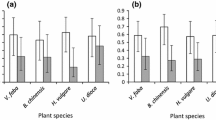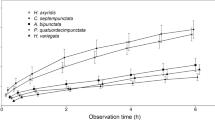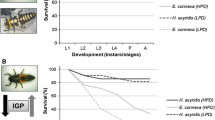Abstract
Introductions of two ladybird beetle (Coleoptera: Coccinellidae) species, Coccinella septempunctata and Harmonia axyridis, into North America for aphid biocontrol have been followed by declines in native species. We examined intraguild predation (IGP) between larvae of these two exotic species and larvae of the two most abundant native coccinellids in eastern Washington State, C. transversoguttata and Hippodamia convergens. In pairings between the two native species in laboratory microcosms containing pea (Pisum sativum) plants, neither native had a clear advantage over the other in IGP. When the natives were paired with either Harmonia axyridis or C. septempunctata, the natives were more frequently the victims than perpetrators of IGP. In contrast, in pairings between the exotic species, neither had an IGP advantage, although overall rates of IGP between these two species were very high. Adding alternative prey (aphids) to microcosms did not alter the frequency and patterns of relative IGP among the coccinellid species. In observations of encounters between larvae, the introduced H. axyridis frequently survived multiple encounters with the native C. transversoguttata, whereas the native rarely survived a single encounter with H. axyridis. Our results suggest that larvae of the native species face increased IGP following invasion by C. septempunctata and H. axyridis, which may be contributing to the speed with which these exotic ladybird beetles displace the natives following invasion.






Similar content being viewed by others
References
Brown MW, Miller SS (1998) Coccinellidae (Coleoptera) in apple orchards of eastern West Virginia and the impact of invasion by Harmonia axyridis. Entomol News 109:136–142
Cottrell TE, Yeargan KV (1999) Intraguild predation between an introduced lady beetle, Harmonia axyridis (Coleoptera: Coccinellidae), and a native lady beetle, Coleomegilla maculata (Coleoptera: Coccinellidae). J Kans Entomol Soc 71:159–163
Day WH, Prokrym DR, Ellis DR, Chianese RJ (1994) The known distribution of the predator Propylea quatuordecimpunctata (Coleoptera: Coccinellidae) in the United States, and thoughts on the origin of this species and five other exotic lady beetles in eastern North America. Entomol News 105:244–256
DeBach P, Rosen D (1991) Biological control by natural enemies. Cambridge University Press, New York
Elberson LR (1992) Studies of the Russian wheat aphid, Diuraphis noxia (Homoptera: Aphididae) and it’s natural enemies in northern Idaho. MS Thesis, University of Idaho
Elliot N, Kieckhefer R, Kauffman W (1996) Effects of an invading coccinellid on native coccinellids in an agricultural landscape. Oecologia 105:537–544
Evans EW (1991) Intra versus interspecific interactions of ladybeetles (Coleoptera: Coccinellidae) attacking aphids. Oecologia 87:401–408
Evans EW (2003) Searching and reproductive behaviour of female aphidophagous ladybirds (Coleoptera: Coccinellidae): a review. Eur J Entomol 100:1–10
Evans EW (2004) Habitat displacement of North American ladybirds by an introduced species. Ecology 85:637–647
Hironori Y, Katsuhiro S (1997) Cannibalism and interspecific predation in two predatory ladybirds in relation to prey abundance in the field. Entomophaga 42:153–163
Hodek I, Honek A (1996) Ecology of Coccinellidae. Kluwer, Boston
Howarth FG (1991) Environmental impacts of classical biological control. Annu Rev Entomol 36:485–509
Kajita Y, Takano F, Yasuda H, Agarwala BK (2000) Effects of indigenous ladybird species (Coleoptera: Coccinellidae) on the survival of an exotic species in relation to prey abundance. Appl Entomol Zool 35:473–479
LaMana ML, Miller JC (1996) Field observations on Harmonia axyridis Pallas (Coleoptera: Coccinellidae) in Oregon. Biol Control 6:232–237
LaMana ML, Miller JC (1998) Temperature dependent development in an Oregon population of Harmonia axyridis (Coleoptera: Coccinellidae). Environ Entomol 27:1001–1005
Louda SM, Kendall D, Connor J, Simberloff D (1997) Ecological effects of an insect introduced for the biological control of weeds. Science 277:1088–1090
Lucas E, Coderre D, Brodeur J (1998) Intraguild predation among aphid predators: characterization and influence of extraguild prey density. Ecology 79:1084–1092
Mack RN, Simberloff D, Lonsdale WM, Evans H, Clout M, Bazzaz FA (2000) Biotic invasions: causes, epidemiology, global consequences, and control. Ecol Appl 10:689–710
Maron JL, Vilà M (2001) Do herbivores affect plant invasion? Evidence for the natural enemies and biotic resistance hypotheses. Oikos 95:363–373
Michaud JP (2002) Invasion of the Florida citrus ecosystem by Harmonia axyridis (Coleoptera: Coccinellidae) and asymmetric competition with a native species, Cycloneda sanquinea. Environ Entomol 31:827–835
Michaud JP (2003) A comparative study of larval cannibalism in three species of ladybirds (Coleoptera: Coccinellidae). J Entomol Sci 28:92–101
Obrycki JJ, Giles KL, Ormrod AM (1998) Interactions between an introduced and indigenous coccinellid species at different prey densities. Oecologia 117:279–285
Osawa N (1993) Population studies of the aphidophagous ladybird beetle Harmonia axyridis (Coleoptera: Coccinellidae): life tables and key factor analysis. Res Pop Ecol 35:335–348
Polis GA, Myers CA, Holt RD (1989) The ecology and evolution of intraguild predation: potential competitors that eat each other. Annu Rev Ecol Syst 20:297–330
Preziosi RF, Snyder WE, Grill CP, Moore AJ (1999) The fitness of manipulating phenotypes: implications for studies of fluctuating asymmetry and multivariate selection. Evolution 53:1312–1318
Rosenheim JA, Kaya HK, Ehler LE, Marois JJ, Jaffee BA (1995) Intraguild predation among biological-control agents: theory and practice. Biol Control 5:303–335
Rutledge CE, Robinson A, Eigenbrode SD (2003) Effects of a simple plant morphological mutation on the arthropod community and the impacts of predators on a principal insect herbivore. Oecologia 135:39–50
Simberloff D, Stiling P (1996) How risky is biological control? Ecology 77:1965–1974
Snyder WE, Hurd LE (1995) Egg hatch phenology and intraguild predation between two mantid species. Oecologia 104:496–500
Snyder WE, Ives AR (2003) Interactions between specialist and generalist natural enemies: parasitoids, predators, and pea aphid biocontrol. Ecology 84:91–107
Tedders WL, Schaeffer PW (1994) Release and establishment of Harmonia axyridis (Coleoptera: Coccinellidae) in the southeastern United States. Entomol News 105:228–243
Torchin ME, Lafferty KD, Dobson AP, McKenzie VJ, Kuris AM (2003) Introduced species and their missing parasites. Nature 421:628–630
Waage JK, Mills NJ (1992) Biological control. In: Crawley M (ed) Natural enemies. Blackwell, Oxford, pp 412–430
Wheeler AG Jr, Stoops CA (1996) Status and spread of the palearctic lady beetles Hippodamia variegata and Propylea quatuordecimpunctata (Coleoptera: Coccinellidae) in Pennsylvania, 1993–1995. Entomol News 107:291–298
White C, Eigenbrode SD (2000) Effects of surface wax variation in Pisum sativum on herbivorous and entomophagous insects in the field. Environ Entomol 29:773–780
Williamson M (1996) Biological invasions. Chapman and Hall, London
Wissinger SA (1992) Niche overlap and the potential for competition and intraguild predation between size-structured populations. Ecology 73:1431–1444
Yasuda H, Ohnuma N (1999) Effect of cannibalism and predation on the larval performance of two ladybird beetles. Entomol Exp Appl 93:63–67
Yasuda H, Kikuchi T, Kindlmann P, Sato S (2001) Relationships between attack and escape rates, cannibalism, and intraguild predation in larvae of two predatory ladybirds. J Insect Behav 14:373–384
Youssef N (2000) The occurrence of coccinellids and aphids inhabiting spring wheat, lentils, and canola in northern Idaho. MS Thesis, University of Idaho
Acknowledgements
G.C. Chang, A.E. Jorgensen, A.M. Koss, R.P. Prasad, D.A. Prischmann, C.S. Straub and F.L. Yoshimi gave valuable suggestions that improved the manuscript.
Author information
Authors and Affiliations
Corresponding author
Rights and permissions
About this article
Cite this article
Snyder, W.E., Clevenger, G.M. & Eigenbrode, S.D. Intraguild predation and successful invasion by introduced ladybird beetles. Oecologia 140, 559–565 (2004). https://doi.org/10.1007/s00442-004-1612-5
Received:
Accepted:
Published:
Issue Date:
DOI: https://doi.org/10.1007/s00442-004-1612-5




